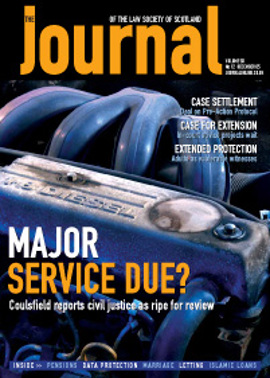The limits of diversification

The Scottish Land Court’s decision (12 September 2005) in Trustees of the Cawdor Scottish Discretionary Trust v Mackay has focused attention on the provisions of Part 3 of the Agricultural Holdings (Scotland) Act 2003, “Use of Agricultural Land: Diversification”.
In Cawdor, the landlords applied for an order upholding the resumption of a cottage under a lease which prohibited subletting to persons other than farm workers, and reserved to the landlords a power of resumption “for any purpose, other than letting to another agricultural tenant” and a special power to resume any dwellinghouse not occupied by a farm worker for a period of three months. The court upheld the resumption notice on the ground that the cottage was surplus to the farm’s requirements, but, in doing so, considered and rejected two lines of defence by the tenant.
The first of these was that the prohibition against subletting and, indeed, the power of resumption itself were terms of the lease which prohibited use of the land for a non-agricultural purpose, rendering them of no effect under section 39(2). The court held that subletting was not a “use” of land, as such. The tenant’s alternative argument was that the prohibition impeded the use of the land for a non-agricultural purpose, entitling the tenant to sublet the cottage under section 39(3). The court held, however, that section 39(3) was available only as an ancillary mechanism to permit the tenant to carry out a non-agricultural activity on the land.
Open to interpretation
The decision, it has to be said, is entirely logical when section 39 is read as a whole, as favoured by the Land Court – is there some comfort to be taken by those of us who consider that section 16 (provisions as to fixed equipment in relation to the new types of tenancy) falls to be read as unum quid? Cawdor gives useful guidance on what the court considers a term of a lease which will be caught by section 39(2) or (3). Beyond that it is of limited value in understanding the scope of the provisions of Part 3 of the Act. It was decided on very specific issues. It remains to be seen what, if any, limitations the court will impose on the extent to which tenants are permitted to diversify into non-agricultural activities.
Leaving aside procedural matters, the grounds on which a landlord may object to a notice of diversification are vague. They are that “the landlord reasonably considers that the intended use of the land for the non-agricultural purpose would (i) lessen significantly the amenity of the land or the surrounding area; (ii) substantially prejudice the use of the land for agricultural purposes in the future; (iii) be detrimental to the sound management of the estate of which the land consists or forms part; or (iv) cause the landlord to suffer undue hardship”. Expressions such as “lessen significantly”, “substantially prejudice” and “undue hardship” leave ample scope for debate. The overarching provision that “the landlord reasonably considers” that the intended use gives rise to one or more of the specific grounds of objection is subject to review by the Scottish Land Court, on an application by the tenant, the outcome of which may be for the court to override the landlord’s objection, or impose its own “reasonable conditions” on use. Also, any “reasonable conditions” which the landlord (legitimately) seeks to impose on use in consenting to a notice of diversification are subject to review by the Land Court. In both cases the court will have to adopt the mantle of “the reasonable landlord”, for which purpose it may find some guidance from the case law relevant to the “fair and reasonable landlord” test to be applied before consent is given to the operation of certain notices to quit.
The thrust of the grounds of objection (and particularly ground (ii)) does appear on one reading to imply that the tenant is empowered to use a small part or small parts only of the holding for non-agricultural purposes, although that interpretation does not, perhaps, sit easily alongside the notion that the planting and cropping of trees is identified specifically as an activity into which tenants may diversify. Commercial forestry is an activity which, for obvious reasons, is more effectively carried out over a comparatively large area. The compensation provisions contained in section 51 also seem to imply that wide scale diversification is anticipated.
Time will, however, tell the extent to which tenants are empowered to diversify under Part 3 and the Land Court is going to have an interesting time interpreting its somewhat vague provisions. I do not hazard a guess at the outcome and will watch the case law as it unfolds with interest.
Alasdair G Fox, Anderson Strathern
In this issue
- Holes in Scotland's corporate killing proposals
- A month of contrasts
- Too small to be flexible?
- Engine overhaul
- Vital voices revisited
- Letting in the law
- Puzzles and paradoxes
- Legacy giving in a Scottish climate
- New deal for PI claims
- Data protection crackdown: do you comply?
- In real terms
- Access route
- Better law-making: just lip service?
- Appealing prospects
- The limits of diversification
- Cashing in on the event
- Farewell then common law marriage
- Scottish Solicitors Discipline Tribunal
- Website reviews
- Book reviews
- Unveiling the Islamic mortgage






